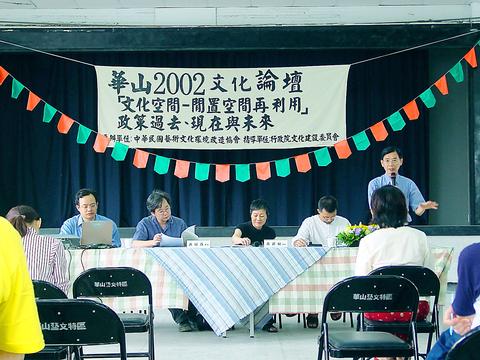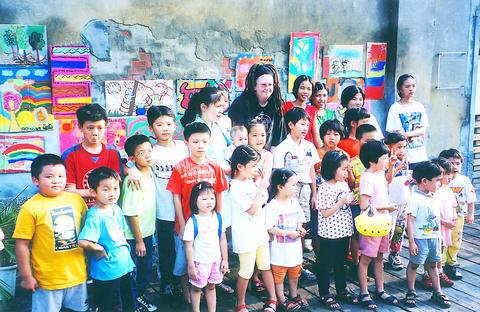Having attracted 42,000 people to its exhibitions, performances and film festivals in 2000, Huashan Arts District (
This high-sounding title don't interest the Association of Culture Environment Reform Taiwan (ACERT), the current manager of Huashan. For many in the group, "Creative Taiwan" signals the start of another management tug of war with the government.

PHOTO COURTESY OF HUASHAN ARTS DISTRICT
In the second annual Seminar on the Policies Concerning the Reuse of Abandoned Spaces: Past, Present and Future (

PHOTO COURTESY OF STOCK 20
Taiwan has just begun taking part in the worldwide trend to reuse old industrial space. The first such case was the transformation of the defunct Chungcheng Second Precinct building into a non-mainstream theater performance venue in 1997. The Council for Cultural Affairs (CCA) put forward the Railway Arts Network Project the same year to reuse warehouses along the railroads, among which are contemporary art-oriented Stock 20 in Taichung and the more grassroots Fangliao Train Station. These two spaces, as well as other spaces taken up by the seminar, were all in cultural fields, suggesting the ways to use abandoned sites are still limited in Taiwan.
The seminar took place in the dimly-lit and poorly-ventilated second floor of Huashan's Fruit Wine Hall, a building exuding faded glory. Some 12 people attended. Almost all were representatives from the spaces and scholars specializing in the subject. DPP Legislator Lin Chuo-shui (林濁水) took part throughout the two-day meeting. In a political environment where interest in cultural affairs seldom wins any votes, Lin's participation pleased the host. However, the first department chief from the CCA, the highest-level government official scheduled to attend the meeting, never showed up. Although his subordinate made it to the seminar and took part in the discussions, his absence was a pity given that this was on opportunity for exchanges between government agencies and the managers of reused spaces.
Unlike last year's seminar, where the managers, architects and scholars from various counties took to the podium with lectures and case studies, this year's seminar emphasized exchange of opinions. Sitting on uncomfortable metal seats in the sweaty room, one could soon sense the despair and mounting anger of the participants.
They were upset about the fact that, at present, with the single exception of Hsinchu's Shahuli Art Village, all the places being reused are government properties, and all of them have to rely on CCA subsidies. Paying for their way, the bureau has much say in management. That all too often frustrates the managers, who are usually also artists and are "idealists by nature," said Chang Ho-ching (
"Like parents who teach their kids to paint but end up killing their imagination by setting too many rules, they want too much control in things we do without first trying to understand our ways," Chang said. Apart from his management work, Chang is a painter and choreographer, staging annual theater productions at Huashan Arts District.
He went on to cite the example of a CCA official who came to visit Huashan and was appalled by the small trees planted there. "The official told me,`Why not cut them down and paint your outside walls prettier. Don't act like we didn't give you money,' and that just showed how little the public sector and the managing artists know how the other does things," Chang said.
"Although Huashan looks very run-down, some installation artists like it this way and many alternative theater workers like the possibilities for interaction with the audience that it offers. But the CCA thinks otherwise," said Huang Hai-ming (
Another rough spot is the prohibition on commercial activities on the sites, which leaves reused spaces with little ability to survive on their own.
Short of funding, the managing artists sometimes cannot even keep their places. Government contracts with the management are subject to yearly renewal, making long-term plans for the space virtually impossible. Sometimes, even contracts are no guarantee. Prototype Art, an art space in Taichung, didn't attend the seminar but sent a petition for participants to sign because they are being forced out of their space. Due to personnel changes in the Cultural Affairs Bureau, their contract, which was supposed to last until 2003 is now annulled.
"It happens that policies change when the officials change. That kind of cultural policy won't get far," said Jiang Yao-xian (蔣耀賢), representative of Chiao-zai To Sugar Factory Art Village in Kaohsiung.
While all the other spaces strongly empathize with Prototype, land is something Hsinchu's Shahuli Art Village doesn't have to worry about. Scheduled to open next month, the art village would be Taiwan's only art village on private land. Having their own land, management enjoys much greater freedom.
"In the US, reused spaces get funding from private organizations, with little government involvement. Apart from greater freedom, the management has a clear division of duties and works with greater efficiency," said artist Ho Shu-zi (
Partly pressured by government policy, partly out of their own will, many managing artists have begun to communicate with local residents. One outstanding example is Chiao-zai To Sugar Factory Art Village's "open studio" it held over the past three years. "We received very encouraging feedback from the local community. ... The public used to imagine all kinds of things about artists. By reaching out to them, even going to the kindergartens, an understanding is achieved," Jiang said.
For Stock 20, interaction with the local community is among its top priorities. The relatively high-profile art space has attracted 100,0000 people since its opening in 2000. Its 12 residential artists regularly hold workshops, which have been well received.
Good public relations are probably due to the fact that it is managed not by artists but by an art consultancy, as is usually the case in other countries.
"Artists may be enthusiastic about art, but when it comes to [running the place], they may not be experienced," said Rose Hsu (徐孝貴), representative from Stock 20.
Still, Stock 20 is not without complaints. "Some of the residents taking part in our activities told us that our exhibits were too `contemporary.' Since contact with the local community is a large part of our work, we can't be too self-assertive. The space has to be more amiable," Hsu said.
The pragmatic legislator Lin doubted if interaction is always positive. "Last time when I was at Stock 20, it had a work on exhibit of a Buddhist statue with its anus bandaged. Considering the religious attitudes of people in southern Taiwan, we'd better be careful in this kind of interaction," Lin said in the closing speech.
With the petition for Prototype making its way around the room, the managing artists are anxious about its fate, which they see as a precursor of their own. "The future is riddled with uncertainties," said Chen Lung-bing (

In the March 9 edition of the Taipei Times a piece by Ninon Godefroy ran with the headine “The quiet, gentle rhythm of Taiwan.” It started with the line “Taiwan is a small, humble place. There is no Eiffel Tower, no pyramids — no singular attraction that draws the world’s attention.” I laughed out loud at that. This was out of no disrespect for the author or the piece, which made some interesting analogies and good points about how both Din Tai Fung’s and Taiwan Semiconductor Manufacturing Co’s (TSMC, 台積電) meticulous attention to detail and quality are not quite up to

April 21 to April 27 Hsieh Er’s (謝娥) political fortunes were rising fast after she got out of jail and joined the Chinese Nationalist Party (KMT) in December 1945. Not only did she hold key positions in various committees, she was elected the only woman on the Taipei City Council and headed to Nanjing in 1946 as the sole Taiwanese female representative to the National Constituent Assembly. With the support of first lady Soong May-ling (宋美齡), she started the Taipei Women’s Association and Taiwan Provincial Women’s Association, where she

Chinese Nationalist Party (KMT) Chairman Eric Chu (朱立倫) hatched a bold plan to charge forward and seize the initiative when he held a protest in front of the Taipei City Prosecutors’ Office. Though risky, because illegal, its success would help tackle at least six problems facing both himself and the KMT. What he did not see coming was Taipei Mayor Chiang Wan-an (將萬安) tripping him up out of the gate. In spite of Chu being the most consequential and successful KMT chairman since the early 2010s — arguably saving the party from financial ruin and restoring its electoral viability —

It is one of the more remarkable facts of Taiwan history that it was never occupied or claimed by any of the numerous kingdoms of southern China — Han or otherwise — that lay just across the water from it. None of their brilliant ministers ever discovered that Taiwan was a “core interest” of the state whose annexation was “inevitable.” As Paul Kua notes in an excellent monograph laying out how the Portuguese gave Taiwan the name “Formosa,” the first Europeans to express an interest in occupying Taiwan were the Spanish. Tonio Andrade in his seminal work, How Taiwan Became Chinese,